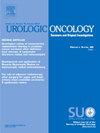68Ga-PSMA PET/CT 和 18F-FDG PET/CT 在前列腺导管癌诊断中的应用。
IF 2.4
3区 医学
Q3 ONCOLOGY
Urologic Oncology-seminars and Original Investigations
Pub Date : 2024-08-03
DOI:10.1016/j.urolonc.2024.07.011
引用次数: 0
摘要
目的探讨前列腺导管腺癌(DA)患者PSMA PET/CT和FDG PET/CT图像的特征:回顾性入选2018年至2022年同济医院PET/CT扫描的前列腺DA患者。前列腺尖腺癌(AA)和良性病变(BP)患者通过1:1配对入组。结果:结果:共有 42 名患者入组:结果:共招募了 42 名患者:每组 14 人。在原发灶中,DA 组的平均 PSMA 摄取量低于 AA 组(14.2 ± 9.6 vs. 27.1 ± 14.3,P = 0.009),高于 BP 组(14.2 ± 9.6 vs. 4.7 ± 1.3,P = 0.003)。DA-AA ROC 曲线和 DA-BP ROC 曲线的 AUC 分别为 0.781 和 0.872。DA组转移淋巴结的PSMA摄取中位数低于AA组(5.6 vs. 14.2,P = 0.033),转移骨病变无显著差异(9.5 vs. 19.1,P = 0.485)。DA组和AA组原发灶和转移灶的FDG摄取量无明显差异(P > 0.05):结论:前列腺DA的PSMA摄取量高于BP疾病,但PSMA PET/CT在原发灶和转移淋巴结的摄取量低于AA,有助于DA、AA和BP疾病的鉴别诊断。临床医生应将传统成像与 PSMA PET/CT 结合起来,以避免低估 DA 患者的临床分期。本文章由计算机程序翻译,如有差异,请以英文原文为准。
68Ga-PSMA PET/CT and 18F-FDG PET/CT in the diagnosis of prostatic ductal cancer
Purposes
To explore the characteristics of PSMA PET/CT and FDG PET/CT images in prostatic ductal adenocarcinoma (DA) patients.
Methods
We retrospectively enrolled prostatic DA patients with PET/CT scans at Tongji Hospital from 2018 to 2022. Patients with prostatic acinar adenocarcinoma (AA) and benign pathology (BP) were enrolled by 1:1 matching. Differences in the uptake of primary and metastatic foci on PET among the groups were analyzed.
Results
A total of 42 patients were enrolled: 14 in each group. In primary foci, the mean PSMA uptake in the DA group was lower than that in the AA group (14.2 ± 9.6 vs. 27.1 ± 14.3, P = 0.009) and greater than that in the BP group (14.2 ± 9.6 vs. 4.7 ± 1.3, P = 0.003). The AUCs of the DA-AA ROC curve and DA-BP ROC curve were 0.781 and 0.872, respectively. The median PSMA uptake of metastatic lymph nodes in the DA group was lower than that in the AA group (5.6 vs. 14.2, P = 0.033), with no significant difference in metastatic bone lesions (9.5 vs 19.1, P = 0.485). No significant difference was found in the FDG uptake of primary and metastatic foci between the DA and AA groups (P > 0.05).
Conclusion
Prostatic DA has greater PSMA uptake than BP diseases, but lower uptake in both primary foci and metastatic lymph nodes than AA on PSMA PET/CT, aiding in the differential diagnosis of DA, AA and BP diseases. Clinicians should combine traditional imaging with PSMA PET/CT to avoid underestimating the clinical stage of DA patients.
求助全文
通过发布文献求助,成功后即可免费获取论文全文。
去求助
来源期刊
CiteScore
4.80
自引率
3.70%
发文量
297
审稿时长
7.6 weeks
期刊介绍:
Urologic Oncology: Seminars and Original Investigations is the official journal of the Society of Urologic Oncology. The journal publishes practical, timely, and relevant clinical and basic science research articles which address any aspect of urologic oncology. Each issue comprises original research, news and topics, survey articles providing short commentaries on other important articles in the urologic oncology literature, and reviews including an in-depth Seminar examining a specific clinical dilemma. The journal periodically publishes supplement issues devoted to areas of current interest to the urologic oncology community. Articles published are of interest to researchers and the clinicians involved in the practice of urologic oncology including urologists, oncologists, and radiologists.

 求助内容:
求助内容: 应助结果提醒方式:
应助结果提醒方式:


